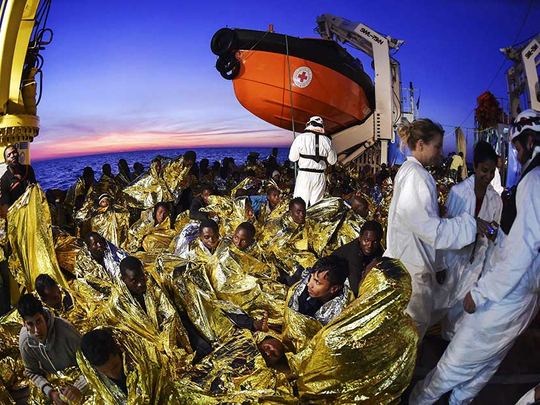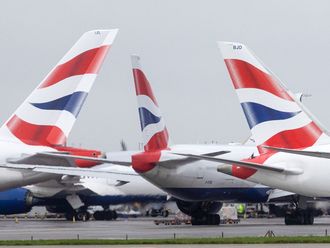
BRUSSELS: Migrants heading to Italy from Libya in leaky boats and inflatable dinghies have broken an annual arrivals record, Italian authorities said this week, underscoring the rising popularity of an increasingly deadly journey that nowadays aims not for land, but for a frigid mid-sea rescue.
The number of boat migrants reaching Italy from North Africa this year surpassed 171,000, topping the previous record of 170,100, set in 2014, the Italian Interior Ministry said earlier this week. But 2016 is also the most lethal year for those trying to cross the Mediterranean to Europe. So far, 4,690 people have died en route, compared with 3,771 deaths for all of last year, according to the UN refugee agency.
The spike in fatalities reflects the ever greater numbers of people attempting the journey deep into autumn, even as the sea turns colder and choppier by the day. More than three times as many reached Italy this November as in the same month last year, the UN says. On Monday alone, Italian and international rescuers reportedly pulled 1,400 people from the water.
People-smugglers in Libya are spreading rumours that the route is about to close, migration groups say, pushing people to undertake the risky journey now rather than wait for better weather.
Last week, at least eight corpses were recovered during rescues that also saved about 1,400 people, and more were thought to be missing. Many of the rescued migrants said smugglers had told them that the Libyan coast guard is about to take over rescue operations and will turn boats back to Libya rather than take them to Italy, as is now usually the case.
The rumours point to a development at the core of the worsening crisis: The rescuers have become a crucial part of the smuggling process. None of the dilapidated smugglers’ boats now actually complete the journey to Italy. Instead, smugglers launch the overcrowded dinghies — often little more than rubber rafts — into the sea, then have the migrants radio or call for help when they are still close to the Libyan coast.
“Smugglers no longer need large and robust boats. They need small boats that can make it a short distance and then have search-and-rescue pick them up,” said Elizabeth Collett, director of the Brussels-based Migration Policy Institute Europe. “How do you break that cycle? You can’t stop search-and-rescue.”
Although the Libyan coast guard and navy are, indeed, stepping up efforts to halt smuggling and return people to shore, they are hampered by Libya’s chaotic civil war and lack of centralised authority. Few Western officials expect the country’s military forces to be able to mount a large-scale effort to intercept the traffic. And even when migrants are turned back, poor conditions in Libya often spur them to make another attempt. For now, the smugglers seem to be feeding migrants’ fears to drum up business.
Migrants often say that they expected better boats for the voyage but that by the time they see the rubber dinghies waiting onshore, the smugglers give them no time to reconsider.
“The tactics appear to be more reckless,” said Joel Millman, a spokesman for the International Organisation for Migration, referring to the smugglers.
Many smugglers launch several dinghies in the same area at once, migration groups say, creating a bigger challenge for rescuers when the vessels capsize. Migrants’ drawings of their journeys show stick figures lined up 20 across, with more people sitting shoulder-to-shoulder on the edges of the boats. One drawing that was given to the UN refugee agency shows a boat with a special section for women, with the rear reserved for jerrycans of fuel. The person who did that drawing said the boat was about 45 feet long.
“It is really the image of the slave boats, all packed in rows,” said Carlotta Sami, a Rome-based spokeswoman for the UN refugee agency. The vessels collapse after travelling just a few miles, she added, “because they are of such a poor quality.”
The people who use the Libyan route are largely from sub-Saharan Africa, mostly from Eritrea, Nigeria and Gambia, according to the UN refugee agency. Most of those who use the route via Turkey are fleeing conflict in Syria, Afghanistan and Iraq.
Flows from Turkey to Greece surged last year to almost 1 million people, then nearly stopped this year. In a deal with the European Union that went into effect in April, Turkey agreed to stem the flow in return for more EU support for refugees and visa-free travel in Europe for Turkish citizens. Since then, about 20,000 asylum seekers and migrants have arrived in Greece, compared with 735,000 during the same period last year.
However, relations between Ankara and the European Union have taken a turn for the worse since a failed coup attempt in July in Turkey led to a political crackdown. Just last week, Turkish President Recep Tayyip Erdogan threatened to unleash a new migration crisis on Europe’s borders by cancelling the deal.
The warning came after the European Parliament voted overwhelmingly to advise mothballing talks with Turkey about the country’s potential EU membership. Although the vote was largely symbolic, it reflected growing concern among European leaders about Turkey’s direction — and a willingness to let the refugee deal lapse despite deep fears about the political strain of taking in more asylum seekers.











